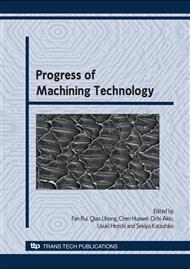p.424
p.428
p.432
p.436
p.440
p.444
p.448
p.452
p.456
Effect of Cutting Edge Roundness on Work Hardened Surface Layer in Metal Cutting
Abstract:
In the ultra-precision machining, the smaller the undeformed chip thickness is, the more the machined surface integrity is affected by the cutting edge roundness of the cutting tool. In this research, the work hardened surface layer was dealt with as an evaluation of the machined surface integrity and the effect of the mechanical factors on work hardening was investigated experimentally in orthogonal cutting. In the case of a rounded cutting edge, unlike a sharp one, it makes the generation mechanism of the work hardened surface layer complicated. In this research, the mechanical dominant factors were investigated by comparing the effect of the rounded cutting edge on the work hardened surface layer, which counts for much in ultra precision machining involved in small undeformed chip thickness, with that of the sharp cutting edge.
Info:
Periodical:
Pages:
440-443
Citation:
Online since:
February 2009
Authors:
Price:
Сopyright:
© 2009 Trans Tech Publications Ltd. All Rights Reserved
Share:
Citation:


